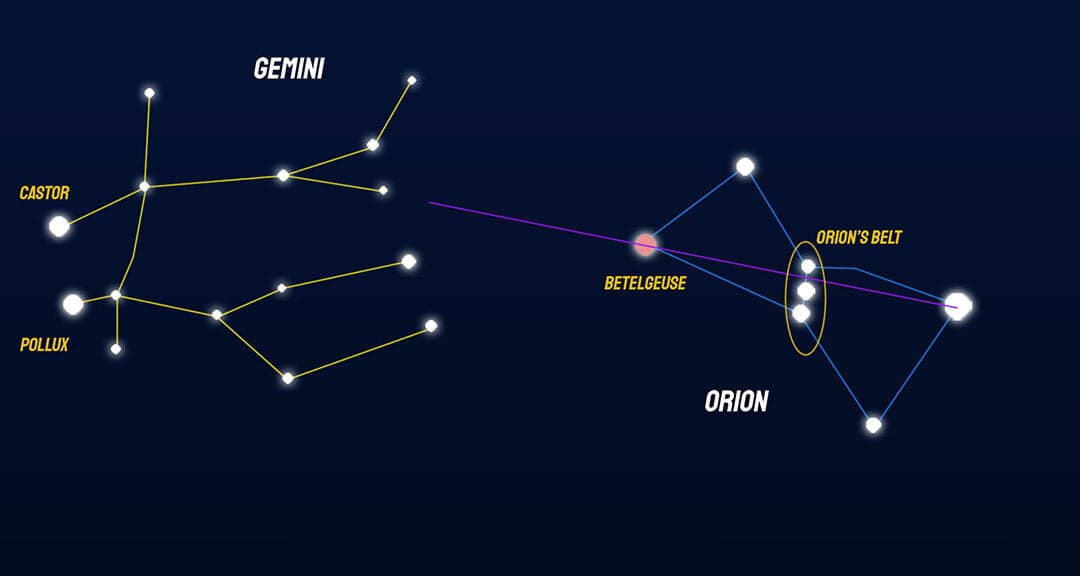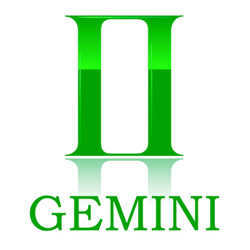
Now, let us direct our attention towards the constellation Gemini. When observing the night sky, this particular constellation is quite prominent from December to May. In close proximity to Gemini, you will find other notable constellations, including Cancer and Lynx. On a night devoid of moonlight, it is possible to behold more than seventy stars, with fourteen of them being especially visible. However, it is often the dazzling stars like Pollux and Castor that capture our gaze and captivate us within this constellation.
What do we know about the Gemini constellation?
The Gemini constellation is composed of multiple rows of stars, with the dimmer stars deviating from them. Together, they form the shape of twin figures. While it may not be possible to discern the exact image, as depicted in ancient star atlases, twin brothers embracing each other were often portrayed.
Within the Gemini constellation, there are several fascinating celestial objects, some of which can be observed without the aid of a telescope. One such object is the star Zeta, which is a long-period variable Cepheid. It exhibits an unusual luminosity that does not have a constant period.
Notably, this star often undergoes changes, which attracts the attention of many scientists. They conduct regular observations in order to uncover any patterns in these period fluctuations.
The star Kappa in the constellation of Gemini belongs to a cluster of vibrant and stunning binary stars. When observing this celestial body through a telescope, we are treated to a breathtaking spectacle: multiple gems glistening together, with one (the primary star) emitting a warm orange glow and the other (its companion) radiating a vibrant green hue.
Another star that captures our attention is Castor. In the vastness of space, it holds the distinction of being the second brightest star. Interestingly, Castor is composed of three components, forming a spectral double star system.
The Legend of Gemini Constellation
Once upon a time, there were two brothers born to King Tyndareus. Their names were Castor and Pollux, and their bond was unbreakable. Castor had a gift for taming wild horses, while Pollux was renowned for his unbeatable skills in fist fights. Together, they became legends.
During one of their adventures, Castor found himself in a dangerous situation and was struck by a spear. In a moment of fury, Pollux avenged his brother by taking down the assailant. However, the loss of his beloved sibling haunted Pollux, and he couldn’t find peace.
Desperate to reunite with his brother, Pollux turned to Zeus for help. Moved by his devotion, Zeus granted Pollux’s wish, and the brothers were forever united in the stars. To this day, the constellation Gemini stands as a testament to their undying love and loyalty.
The king of Sparta had a wife who was renowned for her unparalleled beauty. Zeus, being captivated by her, managed to seduce her. As a result of their affair, she bore two children, one of whom was a son named Pollux. Eventually, she also gave birth to a daughter and another son with her husband, the king, named Castor. Unsurprisingly, Zeus granted his son Pollux immortality, while his brother remained a mortal being.
The brothers grew up together, always by each other’s side and never apart. Therefore, when Castor met his untimely demise, Pollux beseeched his father to allow him to die as well, so that they would not be separated even in the realm of Hades. Zeus granted his son’s request, and since then, the brothers have been inseparable.
According to ancient Greek mythology, brothers were revered as protectors of humanity, and the constellation Gemini was believed to have been created by Zeus to enhance their ability to watch over those in need of assistance.
Thanks to its distinctive arrangement, the Gemini constellation stands out prominently in the night sky. The twin stars, arranged in two parallel chains, can be easily spotted in the northeastern region, near Orion.
On June 21, when the Sun enters the Gemini constellation, it reaches its highest point on the horizon and becomes clearly visible. Therefore, the best time to observe the Gemini constellation is in January or December.
Fascinating objects within the Gemini constellation
Zeta – a star that can be observed without the need for special equipment, captivates experts with its unpredictable period;
Eta – a star that exhibits changes in its brightness;
Kappa – a stunning and luminous binary star. When viewed through a telescope, it appears as two sparkling gems side by side;
Castor – a complex system consisting of six stars;
Adjacent to Castor in the Gemini constellation is the radiant point of a meteor shower, visible from December 7 to December 15. The peak activity is observed on December 13, with up to 60 meteors per hour;
A star cluster composed of approximately 120 stars, easily visible through binoculars or telescopes;
The Clown Planetary Nebula (also known as the Eskimo Nebula) is a tenth-magnitude star surrounded by a uniform and brilliantly illuminated dust shell;
German astronomers have made a remarkable discovery – a planet revolving around the star Pollux in an orbit that is almost perfectly circular. What’s even more astounding is that this planet has a mass that is approximately three times greater than that of Jupiter.

When schoolchildren are learning about the world around them, they may be assigned to write a report on the Gemini constellation. Many beginners in astronomy struggle to locate this constellation because only a few of its stars can be seen with the naked eye. In this article, we will delve into this topic, discuss the history of its origin and discovery, and share some fascinating facts.
The configuration of stars in the sky appears to be in the form of a rectangular shape. This particular pattern becomes apparent when one imagines connecting the most luminous stars together.
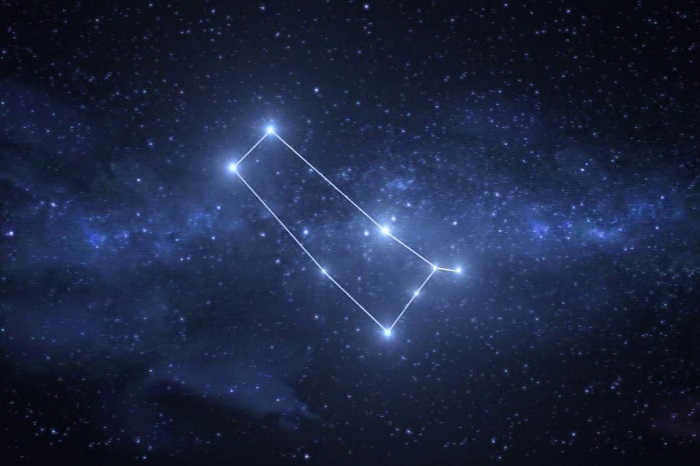
Thus arose the emblem of the star pattern – two linked vertical lines. Adjacent to and encompassed by this conceptual rectangle are additional celestial bodies. However, they possess a lesser degree of visibility.
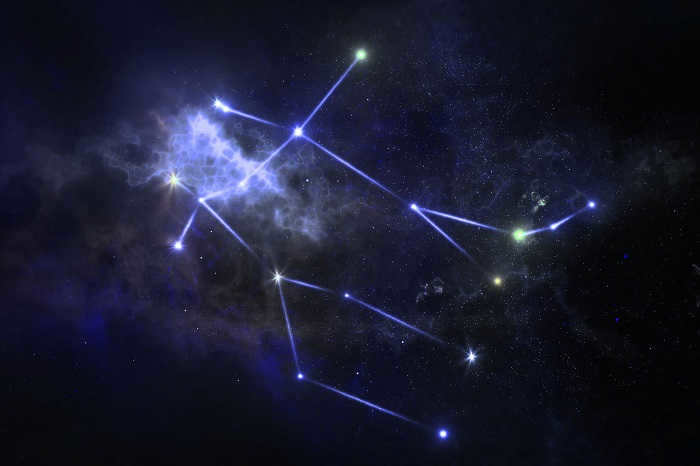
Mythology and historical background of the Gemini constellation
The constellation Gemini has been interpreted differently across various cultures. Certain depictions portray the constellation as a male and female figure. In ancient Babylon, the pair was viewed as a shepherd and a warrior. Meanwhile, the ancient Greeks perceived them as inseparable brothers.
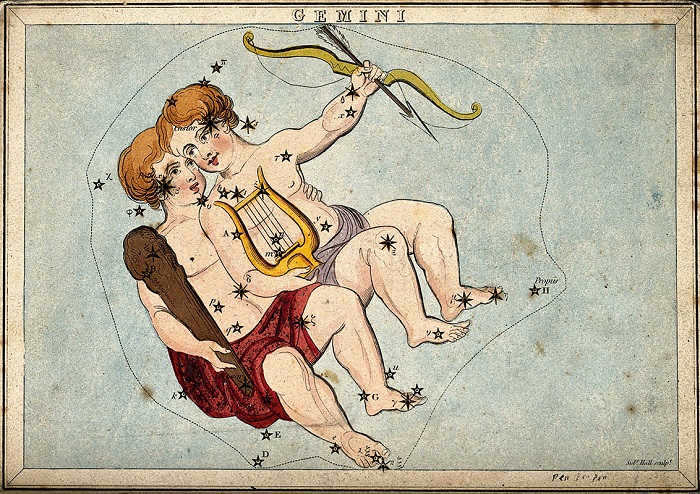
Gemini Constellation’s Stellar Duo
Two of the most prominent stars – Pollux (beta Gemini) and Castor (alpha Gemini). The stars are categorized based on their brightness using the Greek alphabet.
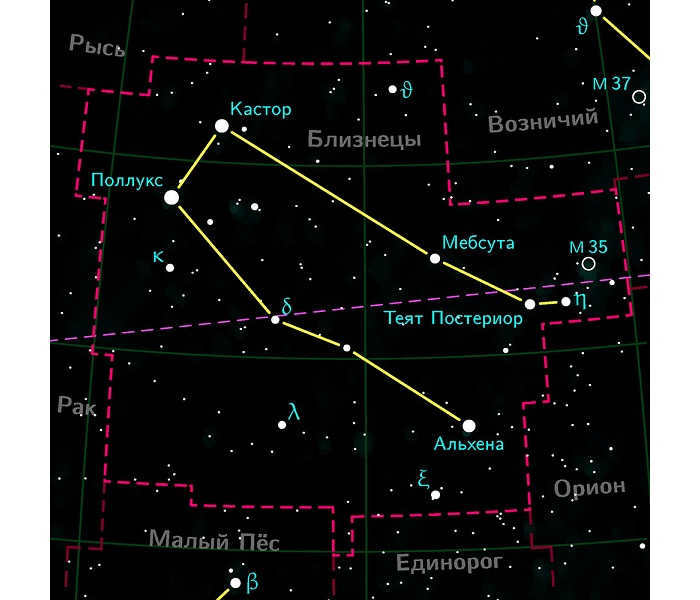
However, in this scenario the designations are organized in a slightly different manner. The most luminous star is Pollux. It is situated 33.7 light-years away from our solar system. The second brightest star is Castor. Castor is quite an extraordinary star. It is a multiple star, meaning it consists of multiple stars, in this particular case 6. As a result, Castor belongs to several spectral classes simultaneously (stars are categorized into spectral classes based on their temperature). Alchena is visible to the naked eye. It is positioned opposite to Pollux.

Moreover, within the Gemini constellation, there exist numerous additional stars. A portion of these stars are visible using regular binoculars, while others can solely be observed through a professional-grade telescope.
Additional celestial objects
Aside from the celestial bodies located within the Gemini constellation, there are also the Eskimo planetary nebula (NGC 2392) and the M 35 diffuse star cluster.
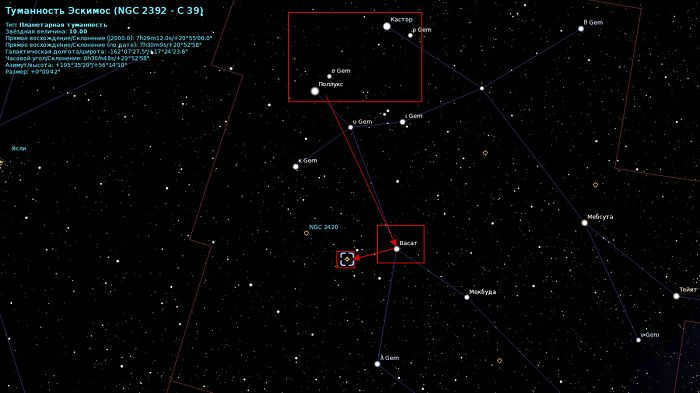
When the Gemini Constellation is Visible
From late autumn to spring, the Gemini constellation can be observed in the night sky. Professional astronomers typically locate celestial objects using coordinates. For beginners, it is recommended to learn how to find specific objects using nearby stars and other constellations.
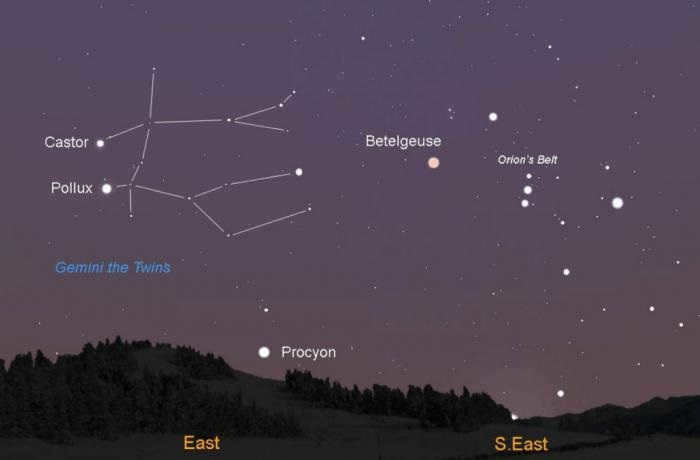
Maybe not everyone, but a lot of people are familiar with the impressive and luminous constellation Orion. It is easily recognizable by the three brilliant points that form a straight line, known as the belt. Adjacent to Orion is Gemini, a constellation that is equally impressive in terms of size and the brightness of its individual stars.
Place
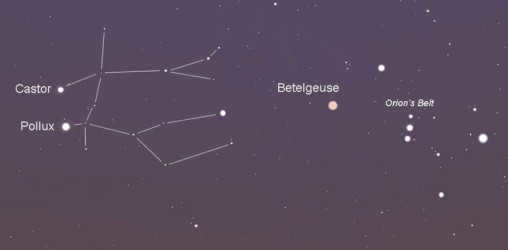

Locating the Gemini constellation in the night sky is a straightforward process. This zodiacal constellation is characterized by two parallel lines of relatively bright stars. To find it, simply start by locating the Orion constellation, specifically its shoulder marked by the reddish and bright star Betelgeuse. From there, look to the northeast to find Gemini. The constellation spans a wide area of the sky, with two nearly parallel lines of luminous points representing Castor and Pollux, the alpha and beta stars of Gemini.
Observing this celestial pattern is possible throughout the entire territory of our country. The best time to do so is during the months of December and January. During this period, the Gemini constellation rises high above the horizon, making it visible and enjoyable throughout the entirety of the night.
The Tale
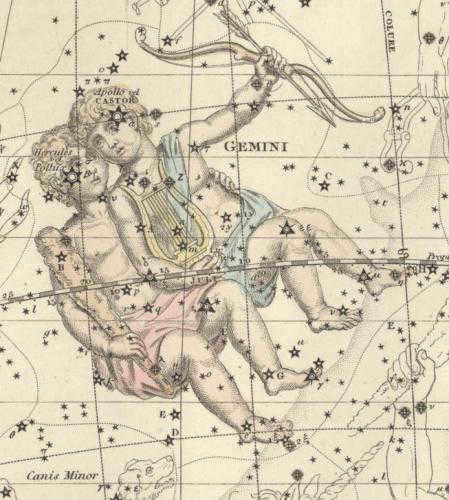
If you observe the constellation of Gemini on ancient maps, it is consistently represented as a pair of young men who bear a striking resemblance to one another. At times, they are depicted armed, while at other times, they are shown happily laughing. Technically speaking, Castor and Pollux were not twins, at least according to one version of the myth. Their mother, the stunningly beautiful Leda, was the wife of King Tindareus of Sparta. However, she did not give birth to him, but to Zeus himself, who fathered her daughter, the famously beautiful Helen, and her son, Polidevka. Castor and Clytemnestra, who came into the world a bit later, were the offspring of the Spartan king.
Polydevk and Castor formed an inseparable bond: they engaged in play together, joined forces with the Argonauts, and achieved victory in numerous competitions. Castor excelled in chariot racing, while Polydevk possessed an unbeatable prowess in fist fights.
Tragically, when Castor met his demise, Polydevk, being immortal by birth, beseeched his father to allow him to pass away so that he could be reunited with his beloved brother. However, Zeus, unwilling to let his son perish, devised a different plan: he granted Polydevk the privilege of spending one day on Olympus with the gods, and another day in the realm of Hades with his brother. As a testament to their brotherly affection, the ruler of the heavens placed the constellation Gemini in the celestial expanse.
A shining pair
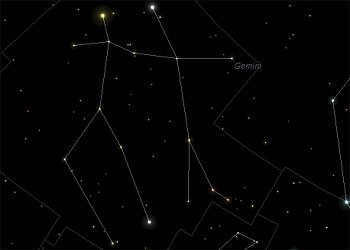
The Gemini constellation possesses numerous remarkable characteristics. It holds a position amongst the oldest constellations, having been documented during antiquity by Ptolemy in his renowned “Almagest”. This celestial arrangement forms part of the zodiacal circle, which serves as the orbit for all planets, as well as the Moon and the Sun.
However, for the average stargazer, one of the most notable aspects of Gemini is the abundance of luminaries it contains. Nearly seventy of these luminaries can be observed with the naked eye on a clear night, with fourteen of them possessing a brightness surpassing the third magnitude. It goes without saying that the two principal stars of this celestial pattern, Castor and Pollux, stand out the most.
Alpha of Gemini
Pollux may be the brightest point in Gemini, but the true alpha of the constellation is Castor. Castor, the second brightest star in Gemini, possesses a range of fascinating characteristics when viewed through an astronomical lens.
Castor is actually a binary star system, consisting of two components that orbit each other every 350 years. Each of these companions is also a double star, meaning there are a total of four luminaries within the Castor system. However, the complexity of the Castor system doesn’t end there. It is also connected to YY Gemini, a relatively faint eclipsing binary star system. This system is commonly referred to as Castor C in scientific literature and takes tens of thousands of years to complete one orbit around the four-star system.
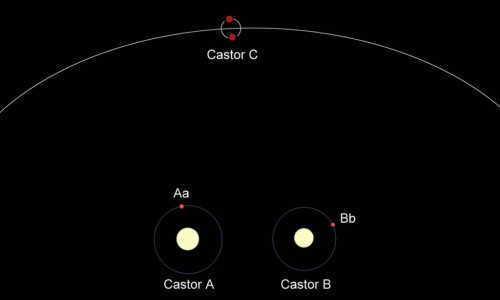
There is another fascinating point connected with Castor: in close proximity to him lies the radiant of one of the meteor streams, known as Geminids. This radiant becomes visible from December 7 to December 15. The stream reaches its peak on the 13th, when it is possible to observe up to 60 meteors per hour.
Everlasting Sibling
The primary radiant point that sets apart the Gemini constellation is the most brilliant star in this heavenly pattern, Pollux. Astronomers have classified the luminary as an orange giant. It has already transitioned from the Main Sequence and will eventually deplete its helium supply on a cosmic scale. This event is projected to occur in a hundred million years. Pollux will shed its gaseous shell and transform into a white dwarf.
Beta Gemini is also a variable star. Furthermore, in 2006, scientists discovered a planet orbiting the orange giant with a period of 589 days. The mass of this celestial object is 2.9 times that of Jupiter.
Vasat
In addition to Castor and Pollux, there are several other celestial objects that make the constellation Gemini well-known. The stars in this constellation may not be as bright as the main pair, but they possess unique characteristics. For example, the delta star of Gemini, also known as Vasat, is only the seventh most luminous star in the constellation. However, it is of great interest to researchers due to its proximity to the ecliptic, the path along which the Sun appears to move throughout the year. Vasat is positioned just 0.2 degrees south of this line.
Nevertheless, the fame of Gemini Delta extends beyond its location on the ecliptic. It was in close proximity to this star that Clyde Tombaugh discovered Pluto in 1930. Vasat serves as a marker for the point at which the dwarf planet intersects the ecliptic during its orbit.
Delta Gemini is classified as an F-class subgiant and possesses unique physical characteristics. It shines with a luminosity that is ten times brighter than the Sun. Interestingly, this star is accompanied by a companion that completes one orbit around it in a span of 1200 years. Moreover, there have been reports suggesting that Delta Gemini might actually be a double star in terms of its spectral composition.
Additional intriguing aspects
The Gemini constellation not only boasts remarkable luminaries, but it also features various other points of interest. If you look closely, you’ll notice a faint spot near the mu and zeta stars of this celestial pattern. This spot is actually a scattered cluster called M35, which consists of approximately 120 stars. It can be observed by individuals who possess a telescope or powerful binoculars.
Another fascinating object that can be observed is the Eskimo planetary nebula, also known as the Clown. This celestial body resembles a small ball and is situated at a distance of 2900 light years away from the Sun.
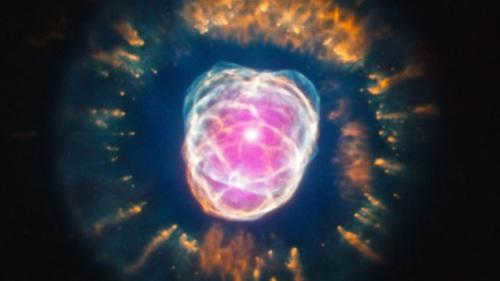
It can be challenging for novice stargazers to connect the two lines of stars with the typical depictions of Gemini found in various literature. However, the collection of rather bright stars that form this constellation, along with a prominent landmark like Orion, make it easier to locate. Telescope owners, on the other hand, have the opportunity to observe all the celestial objects that make up this pattern and fully appreciate the wonders of this part of the universe.
Gemini is the third sign in the zodiac. Its designated time period is May 21 to June 20. Similar to other signs in the zodiac, it corresponds to the Gemini constellation, from which it derived its name.
The Gemini sign is often represented as a rectangle. In fact, if you mentally connect the brightest stars in the Gemini constellation, you will see this shape.
Furthermore, the Roman numeral II can be seen within this sign, indicating the duality of the sign and the dual nature of people born during its active period.
Duality is a sacred principle in many religions, representing concepts such as good and evil, day and night, man and woman, and black and white. The ancient Greeks even started counting with two, considering it to be “the first real number,” rather than one or zero.
In the context of Gemini, the concept of duality can also symbolize confrontation. In many myths, the twins are depicted not as allies, like in the legend of Castor and Pollux, but as rivals.
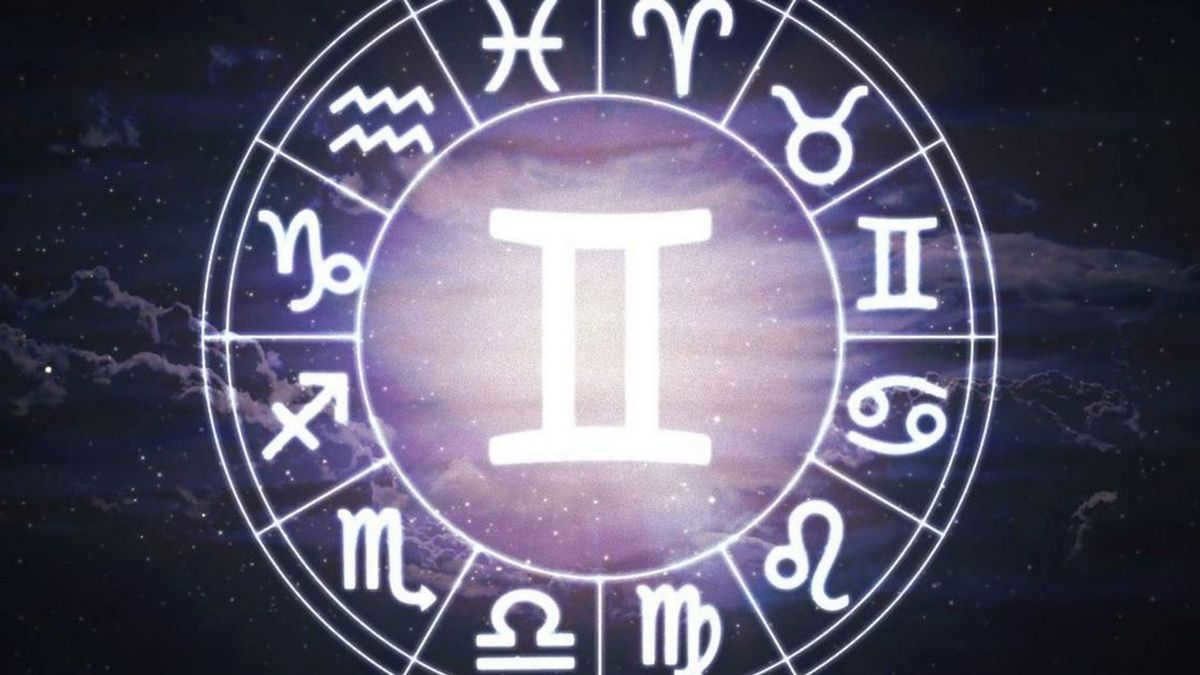

It is not surprising that describing Gemini in just a few words is impossible. Even those closest to them struggle to form a definitive opinion about Gemini. This duality is both their strength and weakness.
What is the distinction between the Gemini sign and the Gemini constellation?
The period when the Sun passes through the Gemini constellation is from June 20 to July 20. However, this does not align with the astrological dominance of the Gemini sign.
The reason for this discrepancy is that the zodiacal system, as we understand it today, was established in the first century BC. Over time, due to the Earth’s rotation and precession, the positions of the stars in the sky have shifted. It will take nearly 30,000 years for these periods to align once again.
Famous Personalities under the Zodiac Sign of Gemini
Locating the Constellation Gemini
Gemini is a constellation that can be observed in the northern hemisphere. It becomes visible in the eastern part of the night sky during autumn and gradually moves towards the west, eventually disappearing behind the horizon by spring.
To locate the constellation Gemini, one can use the nearby constellation Orion, which is positioned to the right and above, and the Lesser Dog, which is located below Gemini.
Moreover, the handle of the Big Dipper also acts as a useful point of reference. If you start from the spot where the handle connects to the scoop (known as Megretz), mentally draw a straight line to the lower right point (known as Merak), and then extend this line, it will lead you to the star Pollux. This star is the brightest beacon in the Gemini constellation. Just above Pollux, you can find the star Castor.
The Gemini constellation is quite expansive. On a clear night, even with the naked eye, you can spot around 70 stars. While Castor is considered the alpha star of the constellation, its brightness is not as intense as its neighbor Pollux. Castor is a binary star, and each component of this binary star is also paired. Scientists also include a faint star called YY Gemini as part of the Castor system.
The tale behind the constellation Gemini
Within Greek mythology, there exists a captivating narrative regarding the constellation Gemini. Leda, the spouse of the Spartan king, fell under the seductive spell of Zeus, who took on the form of a graceful swan. On that very night, she also engaged in intimate relations with her husband. As a result, Leda bore four offspring – two mortal children from her husband and two immortal children from Zeus.
The mortal sibling, Castor, held an immense affection for his immortal brother, Pollux. However, when they decided to marry the cousins of their betrothed partners, a fierce and deadly feud erupted amongst their relatives. Tragically, one of the cousins delivered a fatal blow to Castor.

